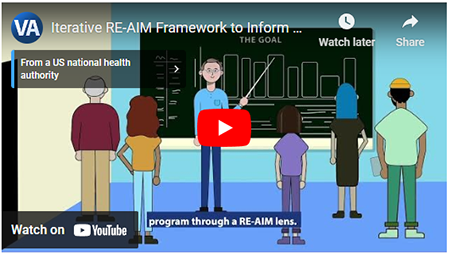Implementation and Adaptation Guide
Home | Table of Contents | Pre-Implementation | Implementation | Sustainment | Resources | Glossary | Contact Us

Iterative RE-AIM
One of the best ways to track (and improve) your healthcare intervention’s progress is to use an established framework like RE-AIM. “RE-AIM” stands for Reach, Effectiveness, Adoption, Implementation, and Maintenance. RE-AIM has been used since 1999 for research and programs in areas of healthcare including aging, cancer screening, disease self-management, nursing research, women’s health, tobacco cessation, weight loss, diabetes prevention, and many more.
The Adaptations Guided by Iterative RE-AIM page explains each of the five-step process for using the RE-AIM dimensions to identify areas where you might need to adapt while you are implementing your intervention. This section also has an interactive worksheet to track your program’s progress along each the five RE-AIM dimensions. Email us if you would like the infographic - Adapting a Program to Your Needs.
Iterative RE-AIM Framework to Inform Adaptations
Here is a breakdown of how you might evaluate your program in a targeted, organized way using the RE-AIM framework as applied in a CHTP program:
| RE-AIM Dimension | Definition | What to Measure | How to Measure It |
|---|---|---|---|
| Reach | The absolute number, proportion, and representativeness of individuals who are willing to participate in a given initiative—in other words, who participates in your program. | WHO is intended to benefit and who actually participates or is exposed to the intervention | Measure number of participants and their similarity of participants to your target group |
| Effectiveness | The impact of an intervention on important outcomes, including potential negative effects, quality of life, and economics. | WHAT are the most important benefits you are trying to achieve and what is the likelihood of negative outcomes? | Measure change on key outcome(s) and consistency across different sub-groups within the overall group of patients served |
| Adoption | The absolute number, proportion, and representativeness of settings and intervention agents who are willing to initiate a program. | WHERE is the program or policy applied and WHO applied it? | Measure which settings and staff take up the intervention and which do not |
| Implementation | The intervention agents’ fidelity to the various elements of an intervention’s protocol. This includes consistency of delivery as intended and the time and cost of the intervention. | HOW consistently is the program or policy delivered, HOW will it be adapted, HOW much will it cost, and WHY will the results come about? | [Need info here] |
| Maintenance | The extent to which a program or policy becomes institutionalized or part of the routine organizational practices and policies. | WHEN will the initiative become operational, how long will it be sustained (setting level), and how long are the results sustained (individual level)? | Measure longevity of effects (individual level) and program sustainability (setting level) |
For more about using RE-AIM as a framework for progress tracking:
- Use this interactive worksheet to conduct a mid-program evaluation. The results can help you make changes to increase the likelihood your project is successfully implemented in your environment.
Previous: Progress Tracking / Next: Worksheet: Mid-Program Progress Tracking





















